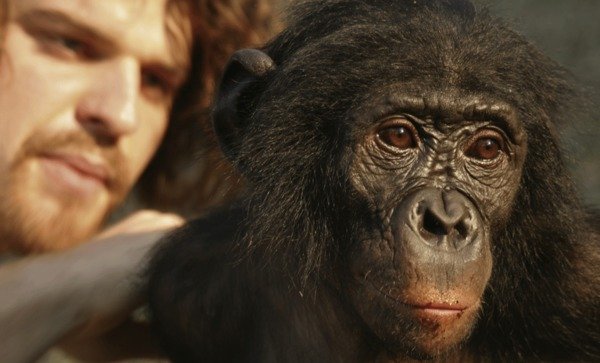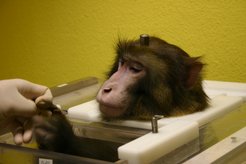
Primate research at Max Planck Institutes
In the wild and in the zoo
Researchers at the Max Planck Institute for Evolutionary Anthropology in Leipzig study both species of large great ape – gorillas and chimpanzees – in the wild and in the zoo. The researchers adopt a multidisciplinary approach to their studies in the wild, which involves both environmental and physiological data (e.g. collecting urine samples to determine hormone status) as well as behavioural data. Among the issues that they study is the question of culture and cognition among chimpanzees. Years of study have revealed how environmental factors influence the evolution of tool use, meat consumption, social structure and culture. In most cases, the animals are simply observed and exposed to only low levels of stress so that their natural behaviour is not disturbed.
The studies on wild monkey populations are conducted in the Taï National Park on the Ivory Coast and in the Loango National Park in Southern Gabon (chimpanzees), in the Salonga National Park in the Democratic Republic of Congo (bonobos/pygmy chimpanzees), in Uganda and Rwanda (mountain gorillas) and in the Central African Republic, the Republic of Congo and Nigeria (western gorilla).
Scientists at the Wolfgang Köhler Primate Research Center (Pongoland), which the Max Planck Society operates in collaboration with Leipzig Zoo, study behaviour and cognition in four species of great ape: chimpanzee (Pan troglodytes), gorilla (Gorilla gorilla), orangutan (Pongo pygmaeus) and bonobo (Pan paniscus). Comparisons between the different species, including humans, should provide clues to the evolutionary origins of the unique human cognitive, social-cognitive and symbolic processes of cultural learning and production.
Pongoland's animal enclosure covers 24,705 square meters of external space, while the buildings cover 3,255 square meters. The research facility is thus the world's largest great ape complex. Visitors to the zoo have the opportunity not only to observe the great apes in their outdoor and indoor enclosures but also to take a look at the research studies that are being carried out. In cooperation with the zoo, the Köhler Center supports efforts to protect and conserve great apes both in the wild and in captivity. The breeding programme at the zoo is framed within the European Endangered Species Programme (EEP) and one of the areas of research addresses the keeping and care of great apes in captivity.
In the lab

Research is also conducted for neuroscientific purposes on non-human primates at an Institute in the Max Planck Society: at the Ernst Strüngmann Institute in Frankfurt. The animals come from various European primate centres. As a general rule, no wild animals are used in Europe! Breeding stations specialising in primates must meet strict conditions and require official authorization in order for German research institutes to be able to acquire animals from them. In addition to documentation on the animals' origin and destination, records must be kept on animal keeping and use in the case of primates. To do this, the precise identity and life story of the animals must be known; the animals must therefore also be individually marked.
Monkeys are only used in animal research if the question cannot be answered with a less highly developed species. An independent commission, which also includes representatives of animal welfare organisations, advises the authorizing agency. Due to this careful decision-making process, fewer than one in a thousand laboratory animals in Germany is an ape. In 2015, Max Planck scientists used 22 monkeys in neuroscientific research, 18 of these were rhesus macaques and 4 were long-tailed macaques. This corresponds to less than 0.01 percent of all laboratory animals at Max Planck Institutes. Scientists work with individual animals over several years, and in the vast majority of cases these animals continue to live in groups at the Institute once the research has been completed.
Risks in using invasive techniques
A complex organ like the brain cannot be studied with either replacement systems like tissue cultures or computer simulations. Even if it were possible to reproduce certain structures, these would not be capable of functioning if they were not linked to sensory organs and muscles, etc. Neurobiological research therefore still relies on the animal model. The use of invasive methods (the insertion of recording electrodes) in the brain is painless, but like every intervention is not without risk, which is also stated in every animal research proposal. It is painless for the animals because brain tissue does not have any touch or pain receptors. Electrodes are also implanted in human brains for diagnostic and therapeutic reasons but do not cause pain for the patients either. In rare cases, however, complications can occur (bleeding, infection), which impair the patient's general condition and require intensive treatment.
The limits of alternative methods
Non-invasive imaging techniques such as magnetic resonance tomography (MRT) and its functional variant (fMRT) and magnetoencephalography (MEG) are used increasingly and successfully in various clinical and experimental studies on humans, for example at the Max Planck Institute for Human Cognitive and Brain Sciences in Leipzig and the Ernst Strüngmann Institute in Frankfurt. However, the results they provide are inconclusive, as the MRT methods only measure blood flow as an indirect gauge of neural activity and the measurements of electrical activities (MEG, EEG) are prone to very poor spatial resolution. Only the total number of activities of millions of neurons in volumes of several cubic centimetres can be recorded using these methods. To research the functions and malfunctions of neural networks, however, the signals of individual neurons need to be measured, and this is currently only possible using invasive methods. The research work carried out at the Max Planck Institute for Biological Cybernetics has established a valuable link between these single electrode recordings and the fMRT technique, which is why some issues can now also be resolved using humans.
